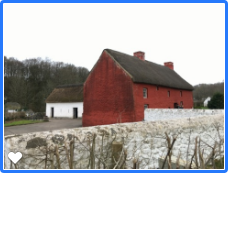Museums to visit
- On Nov, 03, 2020
- Helen & Allen
- Around Tan yr Eglwys
Guests at the cottages are always pleasantly surprised that so many of our museums in Wales are free! The general rule of thumb is that the National Museums of Wales do not charge. There are a few exceptions payment is required at the smaller independent museums.
St Fagans National Museum of History
This is without doubt an absolute gem, it has featured as an extremely popular heritage attraction since 1948. It is seen as a museum of the people. Through the buildings it tells the tale of our Welsh history and our once everyday lives. This is one of the National Museum of Wales sites. Located just to the west of Cardiff, only a few minutes down a dual carriageway from the M4. According to Google this is a 42 mile journey that should take 52 mins, when avoiding peak commuter traffic.
Entry to this 100 acre site is unbelievably FREE (except for car parking charges). St Fagan’s appeals to all ages of the family from the youngest child to the reminiscing grandparents. There are now over 40 original buildings from different historical periods reconstructed on the site. Rural buildings include farm buildings and rural cottages. Urban buildings include terraced houses from a mining community, a chapel, church, school, post office and a bakehouse. A splendid Workmen’s Institute and a tannery are industrial buildings. Each building has passed strict criteria to be demolished in it’s original setting and re built accurately at St Fagans. Each rebuilding a major feat, but the tales and history that accompany each place greatly enhance the experience.
Possibly the reason we all adore St Fagan’s is principally that it stirs up childhood memories. Also the fact that traditional crafts are demonstrated by the now dwindling craftsmen in the re-constructed buildings.

This is undoubtedly an amazing resource and it is easy to spend a day there. The visit and observations are on many different levels. On a sunny day it is a great outdoor space. On a grey day one can delve deeper into the interiors and history. It is easy to not fully explore St Fagan’s in a day. Thus only have a partial insight into the rich culture and heritage of Wales.
The National Waterfront Museum, Swansea
At Swansea Marina, just 9 miles down the valley from Tan yr Eglwys and a stones throw from the beach is The National Waterfront Museum. This is again one of The National Museums of Wales sites, so entry is free. This modern airy building tells the story of the industry and innovation in Wales over the last 300 years. Special contributions are the impact made by Swansea and the surrounding area to the heavy industries. South Wales was an inferno of heavy industries. From metal manufacturing , copper production and mining. Further Swansea was instrumental in developing the railway. This is all well documented here through large working machinery and interactive workstations.
This museum is the oldest museum in Wales, built in 1841. It’s position is near to the Waterfront Museum. It is worth a visit, if only to view the contrasting styles with the Waterfront Museum.. It is quite small and has an eclectic mix of exhibits. Extending from an Egyptian mummy to exhibits of traditional Welsh life. There are generally also contemporary touring or temporary exhibitions.
Again located near the marina. The Dylan Thomas Centre tells the story of the life of Dylan Thomas. From his early childhood in Swansea in 1914 to his untimely death in New York in 1953. This is the largest collection of Dylan Thomas memorabilia. It includes archive material, artwork, photographs, books, rare manuscripts and original sound recordings. The building itself was the original Guildhall for Swansea, so is fittingly grand for this current role. There are sometimes visiting exhibitions. Generally the Centre has interest to anyone with a love or curiosity for the work of Dylan Thomas. It is also known as Tÿ Llen (The House of Literature )and attracts school visits at times. Due to this aspect, the exhibits are presented in an interesting manner with child appeal.
Dylan was born at 5, Cwmdonkin Drive in the Uplands area of Swansea. No 5 has been lovingly restored and awarded the Best Small Attraction in Swansea Bay in 2019. If a lover of all things to do with Dylan Thomas then this is certainly worthy of a visit. It also provides the historical aspect of home-life in the early 1900’s.
The Egypt Centre at Swansea University, Singleton Park campus
If the Egyptian mummy at Swansea Museum whetted the appetite for more Egyptian artefacts and knowledge then this centre will be of interest. It is located at the back of Swansea University, Singleton Campus. This is a very well regarded centre, it was only created in the early nineties. With the objective to publicly exhibit the over 5,000 artefacts that were housed within the departments. These artefacts were largely unseen by the general public.
Entry is free, the museum managed by volunteers, some of whom are students. There is an emphasis on children’s workshops. Undoubtedly the enthusiasm of the volunteers is a major contribution to the experience and very positive reviews.
The Regimental Museum of the Royal Welsh
Formally known as the South Wales Borderers museum, this museum opened in 1935 in Brecon. The collection is a reflection of the 300 year history of The Regiment. The exhibition is of artefacts and memorabilia collected from around the world pertinent to the regiment. There is an extensive archive relating to the Zulu war of 1879, uniforms, weapons and medals.
The museum has an entry fee, the reviews are good with visitors spending varying lengths of time here. It is certainly a must for anyone with a military connection.
The journey to Brecon is very scenic. Once in Brecon there are lovely canal walks, boat trips and nice cafes. Up on the hill above Brecon is the Cathedral, with also a lovely cafe and easy parking. If wanting to go out of Brecon then Llangorse Lake, Talgarth Flour Mill and Hay on Wye are nearby.
An hour away, some 45 miles from the cottage via the A465 is The Big Pit Experience. This is a mine that began working in 1860. Throughout the 19th and 20th Centuries it was one of many mines operating in Blaenavon. It is typical of the industry that covered much of the South Wales valleys. By 1980, the colliery closed and in 1983 the site reopened as an industrial heritage museum.
South Wales was the world leader in coal production. That coal enabled the production of iron and steel. It also fuelled ships that carried the precious metals, coal and other goods across the world from the docklands of S. Wales.
A visit to the Big Pit generally begins at the Pit Head baths building. There are 4 exhibition spaces telling the tale of coal mining in S. Wales and seeing the changes in the role of the miner over a hundred and fifty years. Information regarding the geology of coal, its uses and sadly the mining disasters are displayed. As well as the role of the trade unions and memorabilia of the working men.
Currently due to Covid restrictions the exhibition areas exploring the King Cole and the Mining Experience plus the Underground tour are sadly closed.
The Big Pit sits within the Blaenavon World Heritage Site.
The Blaenavon World Heritage Site
The area that The Big Pit sits within is recognised as a World Heritage Site. The site shows how all the aspects of industry in the area were so very closely connected.
In an area of 3-4 miles across and 6-7 miles in length there are numerous references to the heavy industries that worked here. Including the infrastructure that supported those industries and the waste products. Which now blend in to surrounding landscape.
Students of Industrialisation in South Wales or those with family members involved in the industries, this is an area of immense knowledge. Within this small geographical area much is to be seen. Including the Pontypool & Blaenavon Railway, the Brecknock & Abergavenny Canal, the Govilion Wharf, The Big Pit, the Coity Tip, Gam Lakes, the Varteg Ironworks and Tyla Quarry.
Just a few minutes by car east of Swansea is the independently run World War 2 Experience. With WW2 often part of the school curriculum this museum gives the opportunity for parents and grandparents to share their tales or experiences. An entry fee is applicable. As this is very popular for school visits therefore occasionally school groups present.
Techniquest is a Science and Discovery Centre located in Cardiff bay. It is based over 2 floors of very hands on interactive exhibits, plus a science theatre, planetarium and a laboratory.
Initially established in Cardiff in 1986 and then in Cardiff Bay since the mid 90’s since when generations of school children have visited here on school trips from the reception classes through to secondary years. Equally, many children then return with their family for day trips. It is an extremely popular attraction and we highly recommend particularly a visit here.
Currently with Covid restrictions, it is only open Wed – Sunday with allocated 1/2 day slots. These need to be booked on line in advance and the admission price paid when booking. Some of the pre Covid reviews comment on disappointment, however 2020 has seen the Centre revamped and upgraded. Now it provides a new experience to enthuse, educate and entertain the next generations (and also their parents and grandparents!)
At the site of The Royal Mint. This museum is run as a separate entity. It houses coins, medals, artwork and minting equipment that have been previously owned by the Royal mint.
Additionally a tour of the Royal Mint can be booked in advance





